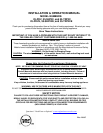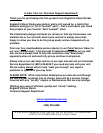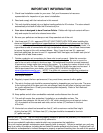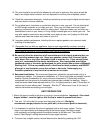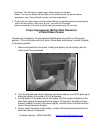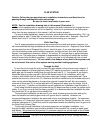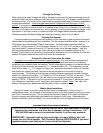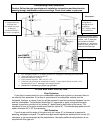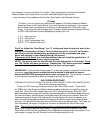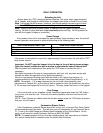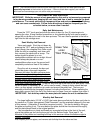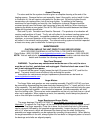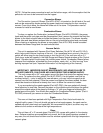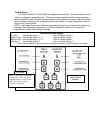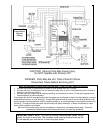
Through the Ceiling
When venting the stove through the ceiling, the pipe is connected the same as through the wall,
except the clean out tee is always on the inside of the house, and a 3” adapter is added before
the clean-out tee. You must use the proper ceiling support flanges and roof flashing supplied by
the pipe manufacturer -- follow the pipe manufacturer’s directions and Illustration 1in this
manual. It is important to note that if your vertical runs of pipe are more than fifteen feet (15’) at
this point, the pellet vent pipe should be increased to four inches (4”) in diameter. Do not exceed
four feet (4’) of pipe on a horizontal run, and do attempt to use the least number of elbows in the
flue system. If an offset is used it is better to install a 45-degree elbow whenever possible.
Please remember, installing elbows may inhibit your draft by up to 15% per elbow.
Existing Flue System
If you are replacing a wood stove with a pellet unit the chimney or pipe should be thoroughly
cleaned before proceeding with the installation. The flue system should be either masonry or a
UL approved pre-manufactured Class A flue system. The flue thimble should be either six
inches (6”) or eight inches (8”) and the proper reducer (6” to 3” or 8” to 3”) can be purchased at
your local dealer. Connect a three inch (3”) tee with clean-out to the pipe adapter -- seal this
with high temperature stove cement, then extend your pipe to the installed reducer at the
thimble. If the thimble is in the ceiling, the pipe will go straight up, but if the thimble is in the wall
another 90-degree elbow will be required to make the connection.
Outside Air (Outside Combustion Air Intake)
Outside air is mandatory for this unit to operate properly
. This unit has been designed and
tested with this connection, because so many homes are airtight and there is not adequate
combustion air available inside the dwelling. The air intake pipe is located on the bottom side of
the burn pot (from the rear) and measures 1 ½” inside diameter (I.D.). The connection can be
made with a metal 1
7
/
8
” I.D. coupler and pipe (see “Important Information” section of manual),
and should exit through the wall. Be sure to secure the pipe to the unit with a clamp or
aluminum tape. The outside end of the pipe should be covered (screened) to prevent foreign
matter from entering the system.
Our Outside Air Kit (Part Number PU-OAK) can be used. If the
unit is located below ground level, you will need to run the pipe up and then outside the
dwelling. NOTE: If the total run of the connection exceeds 6’, if more than 2 elbows are used,
or if a basement installation, use 3” metal pipe (and coupler) instead. Note
: If an older unit,
measure the opening to determine what size pipe to use or couple to.
Mobile Home Installation
Secure the heater to the floor using the two holes in the pedestal. If the unit is on a
combustible surface, you will need to drill matching holes in the floor protection that you choose
(see Floor Protection section). Do not disturb the structural integrity of the home, and be sure
the unit is permanently electrically grounded to the chassis of your home. Remember that
outside combustion air is mandatory, and not to install the unit in a sleeping room of the home.
Important Notes Concerning Installation:
*IMPROPER INSTALLATION: The manufacturer will not be held responsible for damage
caused by the malfunction of a stove due to improper venting or installation. Call
(800-245-6489) and/or consult a professional installer if you have any questions.
IMPORTANT: Improper hook-up (too much pipe, too many elbows, etc.) will
cause the unit not to operate. Call Customer Service (800-245-6489) if you have
questions about your hook-up or if your unit will not operate.



